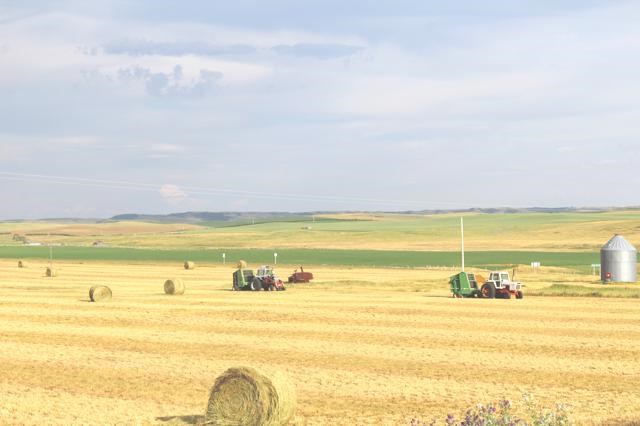The majority of crops across the province are developing normally, Saskatchewan Agriculture reported for the week of July 4 to 10. Normal stages of development for this time of year were recorded provincially for 56 per cent of the fall cereals, 64 per cent of the spring cereals, 62 per cent of the oilseeds and 75 per cent of the pulse crops. Fall cereals were 28 per cent ahead of development and 16 per cent behind. Spring cereals were five per cent ahead of development and 31 per cent behind. Oilseeds were only three per cent ahead of development and 35 per cent behind. Pulses were just five per cent ahead of development and 20 per cent behind.
But crop conditions vary greatly across the province and have deteriorated over the past few weeks due to hot temperatures and a lack of rain. Livestock producers now have 24 per cent of the hay crop cut and 39 per cent baled or put into silage. Hay quality provincially is rated as 17 per cent excellent, 59 per cent good, 22 per cent fair and two per cent poor. Many hay swaths are significantly smaller than normal and pasture growth has been limited. Last year at this time 19 per cent of the hay crop had been cut and 20 per cent had been baled or put into silage.
Although some areas received moisture this past week, many areas still need significant rainfall to help crops develop and replenish the topsoil. Rainfall ranged from negligible amounts in most areas to 80 mm in the Kelvington area. Across the province, topsoil moisture on cropland is rated as two per cent surplus, 41 per cent adequate, 46 per cent short and 11 per cent very short. Hay land and pasture topsoil moisture is rated as three per cent surplus, 32 per cent adequate, 49 per cent short and 16 per cent very short.
High temperatures and a lack of rain continue to damage crops in the province. Many southern and central areas have received less than 100 mm of moisture since April 1. Some crops in these areas are short, thin and heading out and/or flowering earlier than normal due to heat stress. Significant rain is needed to help crops fill and hay and pasture to grow.
Other sources of crop damage this week include hail, localized flooding, wind and insects such as alfalfa weevils, painted lady caterpillars and wheat midge. Leaf spot diseases and root rot are also causing some damage. Producers across the province are haying, scouting for disease and insects, applying fungicides and hauling grain. SaskPower received four reports of farm equipment coming into contact with power lines during this reporting week. Two reports involved spraying equipment.
A year ago, much of the province received significant rain with some areas reporting over 100 mm in a matter of hours. Crops were at their normal developmental stages and most were in good-to-excellent shape.
In southwestern Saskatchewan, livestock producers now have 23 per cent of the hay crop cut and 57 per cent baled or put into silage. Hay quality is currently rated as eight per cent excellent, 58 per cent good and 34 per cent fair. Many producers have reported that hay yields are significantly lower than normal and, in some cases, are as much as 50 per cent lower.




